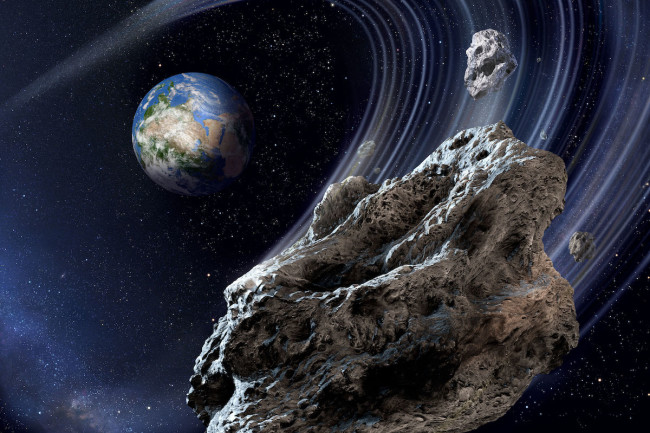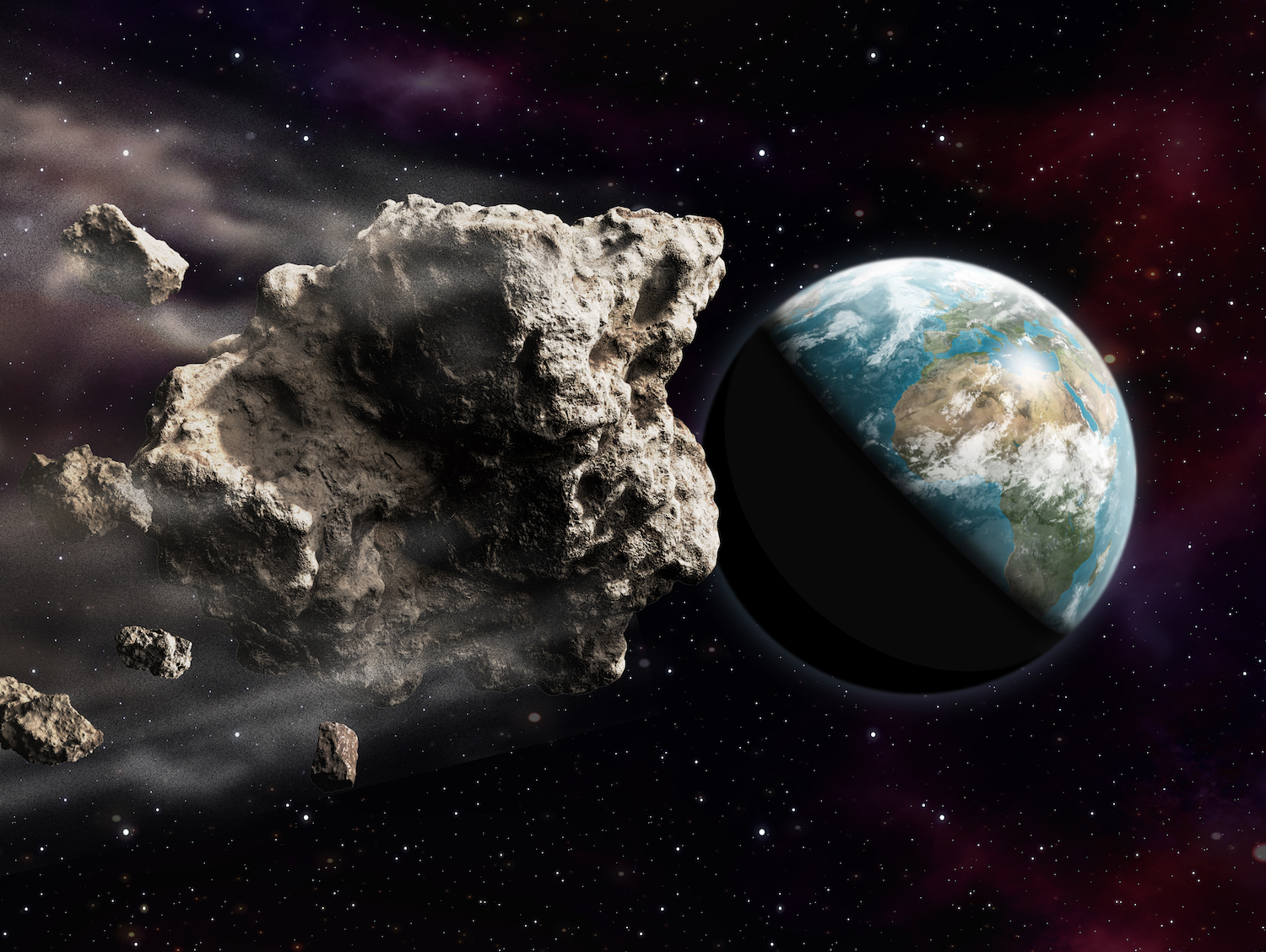Space experts this week warned of an Olympic swimming pool-sized space rock that might hit Earth on Valentine’s Day 2046 – but how many more are out there?
The good news is that it’s not time to head to the Doomsday bunkers yet – the Valentine’s Day asteroid (2023 DW) was rapidly given lower odds of hitting Earth.
But there are several asteroids out there with the potential to hit Earth in the coming centuries – although space agencies around the world are keeping a close eye on these.

Scroll down to read about the six asteroids:
NASA has also conducted a successful experiment where a small spacecraft deflected a space rock by ramming into it.
The good news is that very large asteroids – of the type that killed the dinosaurs – are being monitored, and all have been deemed ‘extremely unlikely’ to hit Earth.
NASA says that every day, more than 100 tons of rocky particles hit Earth – but football-field-sized asteroids only hit every 2,000 years.
Civilization-ending asteroids only collide with our planet once every few million years – and any rocks of this size are being closely watched.
So rocks most likely to hit Earth will probably burn up in the atmosphere or cause minimal damage – rather than being the civilization-ending impact beloved of Hollywood films.
Smaller rocks can have an impact though: the Chelyabinsk meteor which left 1,500 injured in 2013 when it exploded over Russia was just 59 feet in diameter.

During the 2013 Chelyabinsk event, 1500 people were injured and 7,300 buildings damaged by the intense overpressure generated by the shockwave at Earth’s surface.
NASA and other space agencies closely monitor ‘Potentially Hazardous Asteroids’.
Asteroids are rated on their likelihood of impacting Earth on three scales – the Torino Scale, a one-to-ten chart from 0 (won’t hit Earth) to 10 (will hit Earth, and will be catastrophic).
At present, no asteroid is ranked above one.
The related Palermo Scale is used by scientists to rank risk over a longer period – and NASA’s Sentry Risk table classifies asteroids by their risk of hitting Earth.
Initial observations of asteroids tend to be brief, and as scientists get more data, the probability of impact drops.
Name: 2023 DW
Chances of impact? One in 1,584
Date of potential impact: 14 Feb 2046

Experts warned this week that this 160-foot asteroid could cause an explosion similar to the Tunguska event, which flattened more than 80 million trees.
But the odds of the rock hitting Earth on Valentine’s Day 2046 have since been substantially reduced.
Richard Moissl, head of the ESA’s planetary defence office reduced the odds of the asteroid hitting Earth from one in 784 to one in 1,584.
Moissi said: ‘It will go down now with every observation until it reaches zero in a couple of days at the latest. No one needs to be worried about this guy.’
Name: Bennu
Chances of impact? One in 2,700
Date of potential impact: 24 Sept 2182
Bennu is very slightly wider than the height of New York’s Empire State Building, and was visited by NASA’s Osiris-Rex spacecraft in 2020, which collected material from its surface.
Bennu is more than 4.5 billion years old – and scientists estimate that it has a one in 2,700 chance of impacting Earth during the late 22nd century.
Professor Dante Lauretta of the University of Arizona previously said that an impact with Bennu would release, ‘three times more energy than all nuclear weapons detonated throughout history”.
‘The impact would release energy equivalent to 1,450 megatons of TNT.’
‘For comparison, the fission bombs used in World War II had an energy release of roughly 20 kilotons of TNT each and the most powerful nuclear weapon ever detonated, the Russian Tsar Bomba, had a yield of 50 megatons.’
Name: 2010RF12
Chances of impact? One in 10
Date of potential impact: 5 Sept 2095
This asteroid is classified as the most likely to hit our planet in the next century, with a one-in-ten chance of hitting Earth – but don’t panic, it’s pretty tiny.
The space rock is scheduled to arrive just before the end of this century, but it’s thought to be around 21 feet in diameter.
So rather than hitting the surface, it’ll probably explode in a huge air burst in the upper atmosphere, with the only thing reaching the ground being pebbles.
Name: 1950 DA
Chances of impact? One in 34,000
Date of potential impact: March 16, 2880
This half-mile-wide asteroid has a fairly high risk of hitting Earth, with a one in 34,000 chance.
It has also been given a high ranking of risk due to its size – but it won’t arrive for another eight centuries.
First spotted in 1950, hence the name, it’s since been observed at the turn of the millennium.
In 2032, it will make a close-ish pass, 6,959,357 miles away, which will allow further observations.
NASA points out that we have 35 generations to deal with the problem.
NASA says, ‘If it is eventually decided 1950 DA needs to be diverted, the hundreds of years of warning could allow a method as simple as dusting the surface of the asteroid with chalk or charcoal, or perhaps white glass beads, or sending a solar sail spacecraft that ends by collapsing its reflective sail around the asteroid.
‘These things would change the asteroids reflectivity and allow sunlight to do the work of pushing the asteroid out of the way.’
Name: Toutatis
Chances of impact? N/A
Date of potential impact: 2562

The huge asteroid sparked fear in 2004, but won’t be back for quite a while (NASA)

Toutatis won’t be back near Earth for some time (NASA)
This huge asteroid is three miles wide, and gave Earth a close shave in 2004, passing four times the distance from Earth to the Moon – and sparking a wave of unjustified predictions of doom.
It won’t make another close pass like this until 2562, NASA predicts.
NASA says, ‘Because of an extensive set of optical and radar observations, the orbit for Toutatis is one of the best determined of any asteroid and there is no chance that this object will collide with the Earth during this encounter – or any other encounter for at least five centuries.’
Source: amazingastronomy.thespaceacademy.org








